APIE Approach: Problem-Solving and Case Study of Joe's Behavior
VerifiedAdded on 2020/12/18
|12
|4394
|334
Report
AI Summary
This report provides an in-depth analysis of the APIE (Assessment, Planning, Implementation, Evaluation) approach in healthcare, emphasizing its significance in problem-solving and improving patient outcomes. It explores how this method helps healthcare professionals assess patient needs, develop effective interventions, and evaluate the impact of these interventions. The report then delves into a case study of an individual named Joe, examining his behavioral issues through psychological, sociological, and biological lenses. It uses the 'glasses and porridge' concept to analyze the different factors influencing Joe's behavior, including Erikson's stages of psychosocial development, sociological factors such as ethics and values, and biological aspects related to personal traits and metabolism. The report also discusses the Gibbs reflective model, providing a framework for understanding and reflecting on the case study. The analysis highlights how nurses' behaviors and actions, specifically unethical practices, can significantly impact a patient's mental and physical health. The report concludes by summarizing the findings and emphasizing the importance of a holistic approach to patient care.
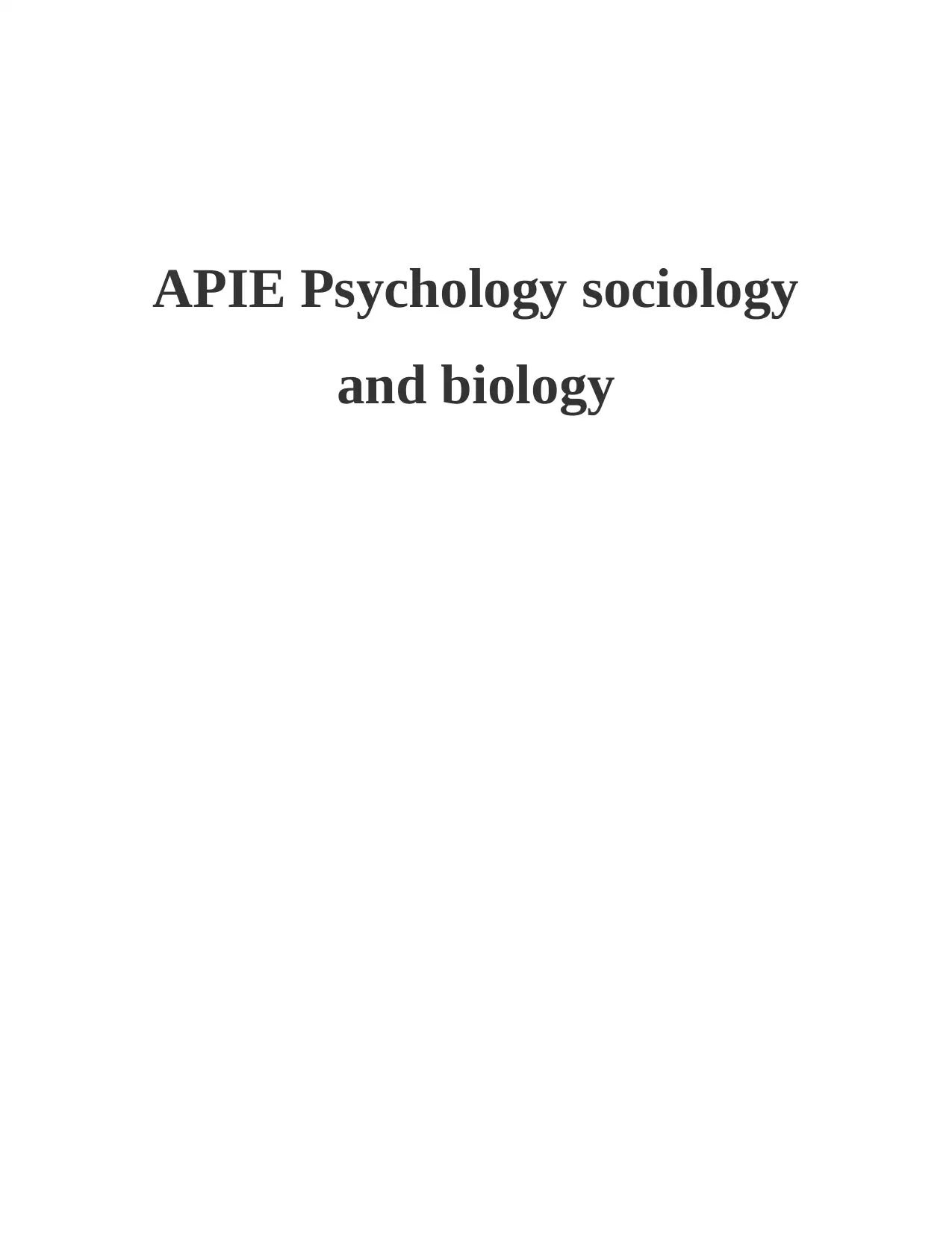
APIE Psychology sociology
and biology
and biology
Paraphrase This Document
Need a fresh take? Get an instant paraphrase of this document with our AI Paraphraser

Table of Contents
INTRODUCTION...........................................................................................................................1
PROBLEM SOLVING APPROACH AND ITS SIGNIFICANCE................................................1
APIE Approach............................................................................................................................1
BEHAVIOUR RELATED TO CASE STUDY OF JOE.................................................................4
GLASSES....................................................................................................................................4
PORRIDGE.................................................................................................................................6
REFLECTION.................................................................................................................................7
Gibbs reflective model.................................................................................................................7
CONCLUSION................................................................................................................................9
REFERENCES..............................................................................................................................10
INTRODUCTION...........................................................................................................................1
PROBLEM SOLVING APPROACH AND ITS SIGNIFICANCE................................................1
APIE Approach............................................................................................................................1
BEHAVIOUR RELATED TO CASE STUDY OF JOE.................................................................4
GLASSES....................................................................................................................................4
PORRIDGE.................................................................................................................................6
REFLECTION.................................................................................................................................7
Gibbs reflective model.................................................................................................................7
CONCLUSION................................................................................................................................9
REFERENCES..............................................................................................................................10
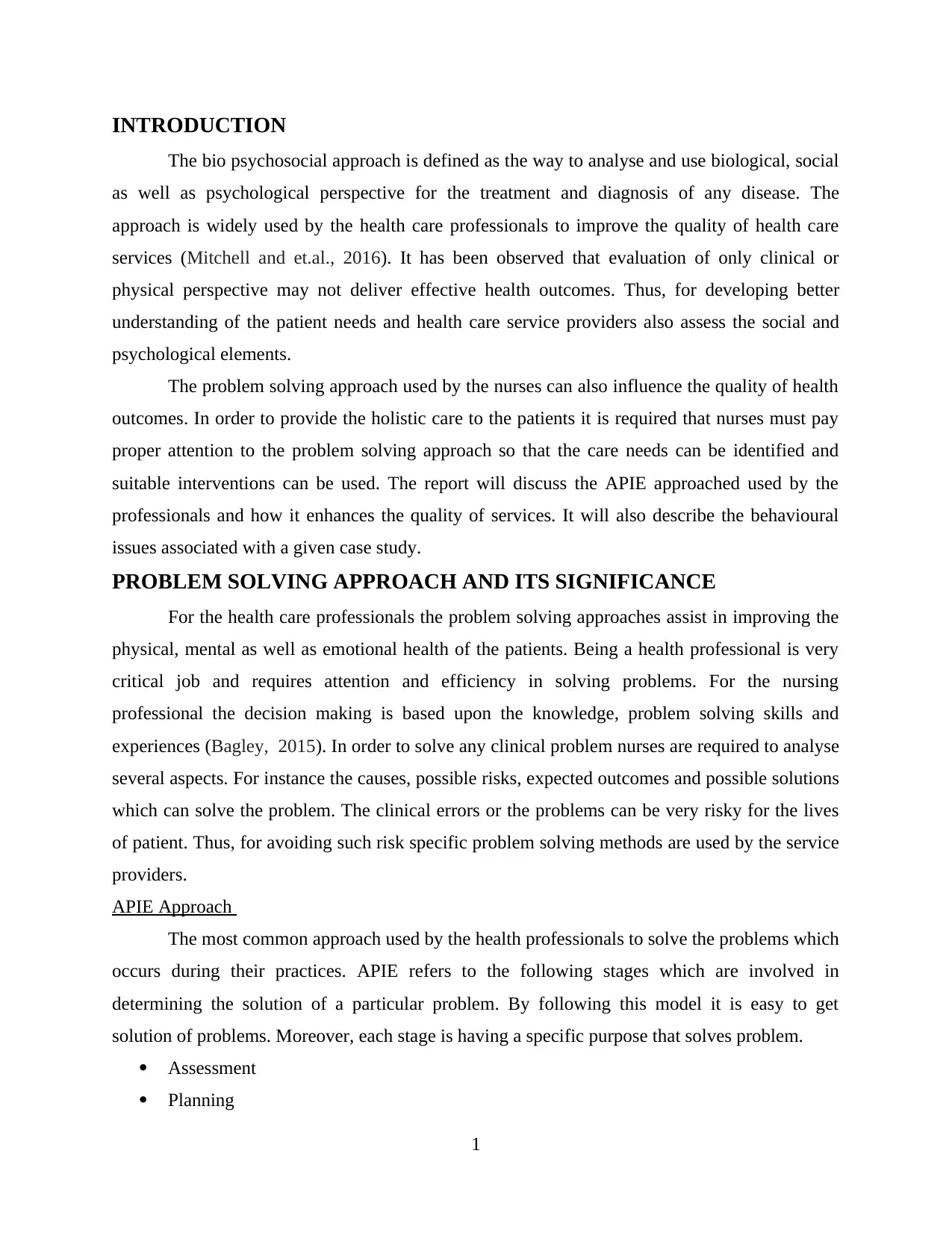
INTRODUCTION
The bio psychosocial approach is defined as the way to analyse and use biological, social
as well as psychological perspective for the treatment and diagnosis of any disease. The
approach is widely used by the health care professionals to improve the quality of health care
services (Mitchell and et.al., 2016). It has been observed that evaluation of only clinical or
physical perspective may not deliver effective health outcomes. Thus, for developing better
understanding of the patient needs and health care service providers also assess the social and
psychological elements.
The problem solving approach used by the nurses can also influence the quality of health
outcomes. In order to provide the holistic care to the patients it is required that nurses must pay
proper attention to the problem solving approach so that the care needs can be identified and
suitable interventions can be used. The report will discuss the APIE approached used by the
professionals and how it enhances the quality of services. It will also describe the behavioural
issues associated with a given case study.
PROBLEM SOLVING APPROACH AND ITS SIGNIFICANCE
For the health care professionals the problem solving approaches assist in improving the
physical, mental as well as emotional health of the patients. Being a health professional is very
critical job and requires attention and efficiency in solving problems. For the nursing
professional the decision making is based upon the knowledge, problem solving skills and
experiences (Bagley, 2015). In order to solve any clinical problem nurses are required to analyse
several aspects. For instance the causes, possible risks, expected outcomes and possible solutions
which can solve the problem. The clinical errors or the problems can be very risky for the lives
of patient. Thus, for avoiding such risk specific problem solving methods are used by the service
providers.
APIE Approach
The most common approach used by the health professionals to solve the problems which
occurs during their practices. APIE refers to the following stages which are involved in
determining the solution of a particular problem. By following this model it is easy to get
solution of problems. Moreover, each stage is having a specific purpose that solves problem.
Assessment
Planning
1
The bio psychosocial approach is defined as the way to analyse and use biological, social
as well as psychological perspective for the treatment and diagnosis of any disease. The
approach is widely used by the health care professionals to improve the quality of health care
services (Mitchell and et.al., 2016). It has been observed that evaluation of only clinical or
physical perspective may not deliver effective health outcomes. Thus, for developing better
understanding of the patient needs and health care service providers also assess the social and
psychological elements.
The problem solving approach used by the nurses can also influence the quality of health
outcomes. In order to provide the holistic care to the patients it is required that nurses must pay
proper attention to the problem solving approach so that the care needs can be identified and
suitable interventions can be used. The report will discuss the APIE approached used by the
professionals and how it enhances the quality of services. It will also describe the behavioural
issues associated with a given case study.
PROBLEM SOLVING APPROACH AND ITS SIGNIFICANCE
For the health care professionals the problem solving approaches assist in improving the
physical, mental as well as emotional health of the patients. Being a health professional is very
critical job and requires attention and efficiency in solving problems. For the nursing
professional the decision making is based upon the knowledge, problem solving skills and
experiences (Bagley, 2015). In order to solve any clinical problem nurses are required to analyse
several aspects. For instance the causes, possible risks, expected outcomes and possible solutions
which can solve the problem. The clinical errors or the problems can be very risky for the lives
of patient. Thus, for avoiding such risk specific problem solving methods are used by the service
providers.
APIE Approach
The most common approach used by the health professionals to solve the problems which
occurs during their practices. APIE refers to the following stages which are involved in
determining the solution of a particular problem. By following this model it is easy to get
solution of problems. Moreover, each stage is having a specific purpose that solves problem.
Assessment
Planning
1
⊘ This is a preview!⊘
Do you want full access?
Subscribe today to unlock all pages.

Trusted by 1+ million students worldwide
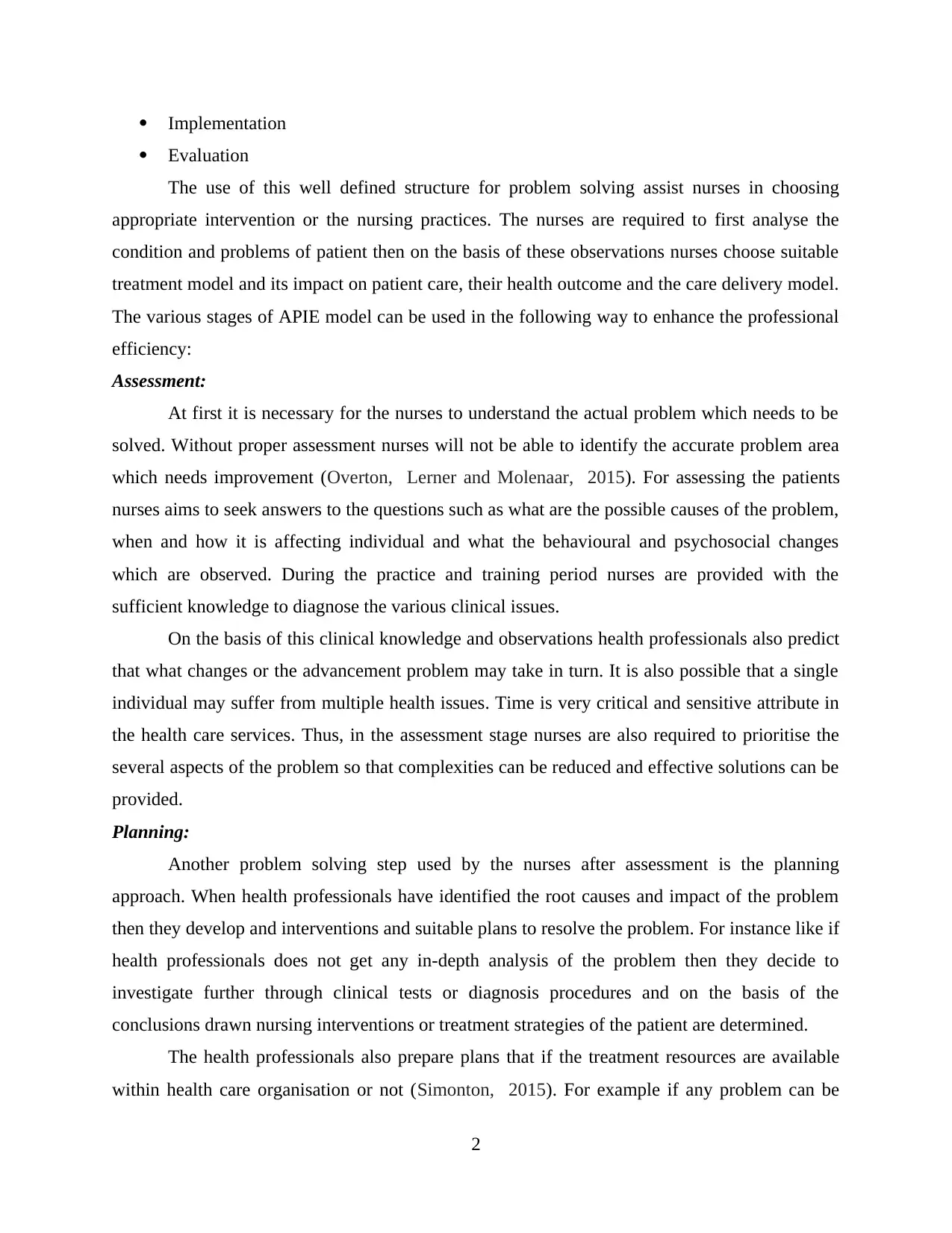
Implementation
Evaluation
The use of this well defined structure for problem solving assist nurses in choosing
appropriate intervention or the nursing practices. The nurses are required to first analyse the
condition and problems of patient then on the basis of these observations nurses choose suitable
treatment model and its impact on patient care, their health outcome and the care delivery model.
The various stages of APIE model can be used in the following way to enhance the professional
efficiency:
Assessment:
At first it is necessary for the nurses to understand the actual problem which needs to be
solved. Without proper assessment nurses will not be able to identify the accurate problem area
which needs improvement (Overton, Lerner and Molenaar, 2015). For assessing the patients
nurses aims to seek answers to the questions such as what are the possible causes of the problem,
when and how it is affecting individual and what the behavioural and psychosocial changes
which are observed. During the practice and training period nurses are provided with the
sufficient knowledge to diagnose the various clinical issues.
On the basis of this clinical knowledge and observations health professionals also predict
that what changes or the advancement problem may take in turn. It is also possible that a single
individual may suffer from multiple health issues. Time is very critical and sensitive attribute in
the health care services. Thus, in the assessment stage nurses are also required to prioritise the
several aspects of the problem so that complexities can be reduced and effective solutions can be
provided.
Planning:
Another problem solving step used by the nurses after assessment is the planning
approach. When health professionals have identified the root causes and impact of the problem
then they develop and interventions and suitable plans to resolve the problem. For instance like if
health professionals does not get any in-depth analysis of the problem then they decide to
investigate further through clinical tests or diagnosis procedures and on the basis of the
conclusions drawn nursing interventions or treatment strategies of the patient are determined.
The health professionals also prepare plans that if the treatment resources are available
within health care organisation or not (Simonton, 2015). For example if any problem can be
2
Evaluation
The use of this well defined structure for problem solving assist nurses in choosing
appropriate intervention or the nursing practices. The nurses are required to first analyse the
condition and problems of patient then on the basis of these observations nurses choose suitable
treatment model and its impact on patient care, their health outcome and the care delivery model.
The various stages of APIE model can be used in the following way to enhance the professional
efficiency:
Assessment:
At first it is necessary for the nurses to understand the actual problem which needs to be
solved. Without proper assessment nurses will not be able to identify the accurate problem area
which needs improvement (Overton, Lerner and Molenaar, 2015). For assessing the patients
nurses aims to seek answers to the questions such as what are the possible causes of the problem,
when and how it is affecting individual and what the behavioural and psychosocial changes
which are observed. During the practice and training period nurses are provided with the
sufficient knowledge to diagnose the various clinical issues.
On the basis of this clinical knowledge and observations health professionals also predict
that what changes or the advancement problem may take in turn. It is also possible that a single
individual may suffer from multiple health issues. Time is very critical and sensitive attribute in
the health care services. Thus, in the assessment stage nurses are also required to prioritise the
several aspects of the problem so that complexities can be reduced and effective solutions can be
provided.
Planning:
Another problem solving step used by the nurses after assessment is the planning
approach. When health professionals have identified the root causes and impact of the problem
then they develop and interventions and suitable plans to resolve the problem. For instance like if
health professionals does not get any in-depth analysis of the problem then they decide to
investigate further through clinical tests or diagnosis procedures and on the basis of the
conclusions drawn nursing interventions or treatment strategies of the patient are determined.
The health professionals also prepare plans that if the treatment resources are available
within health care organisation or not (Simonton, 2015). For example if any problem can be
2
Paraphrase This Document
Need a fresh take? Get an instant paraphrase of this document with our AI Paraphraser
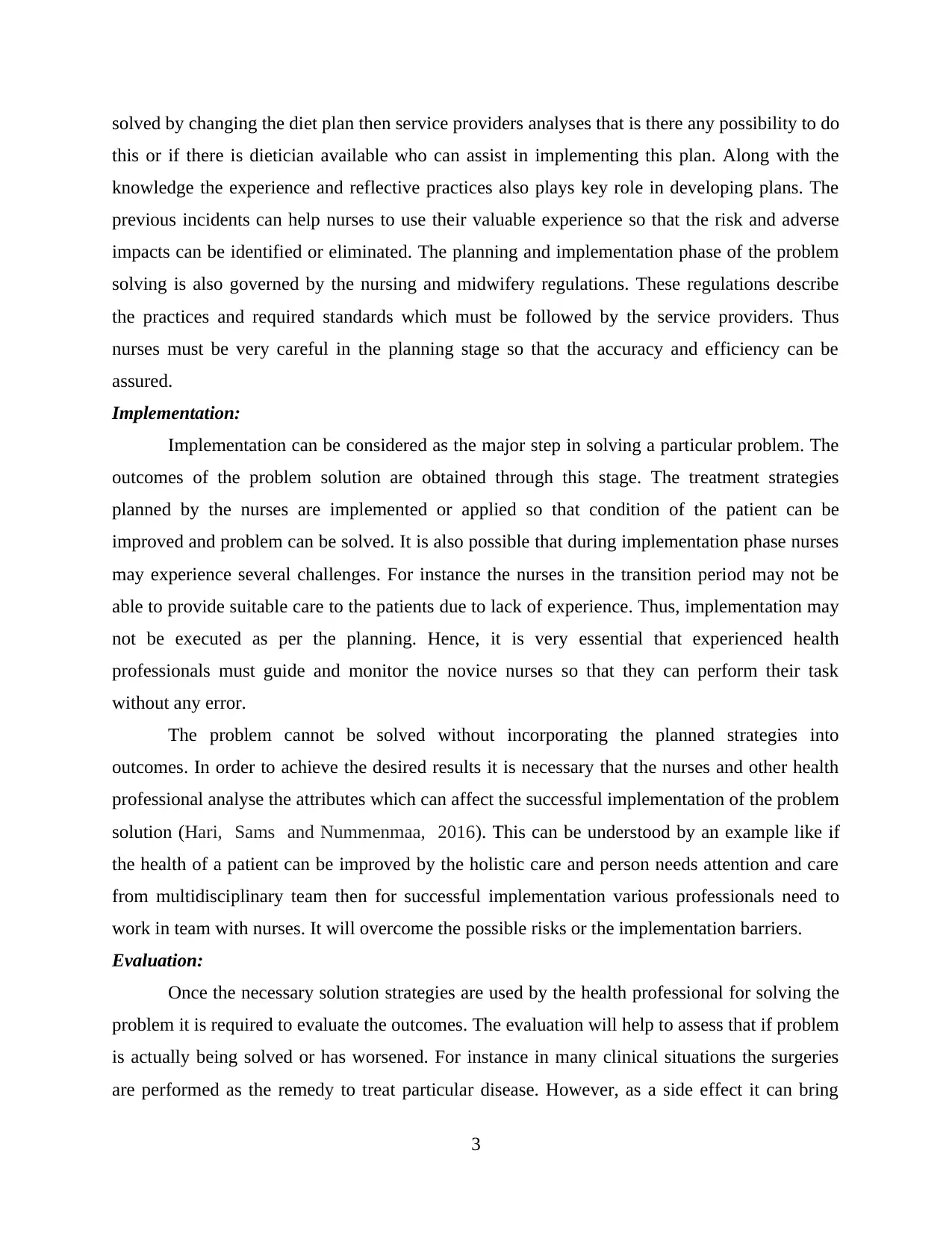
solved by changing the diet plan then service providers analyses that is there any possibility to do
this or if there is dietician available who can assist in implementing this plan. Along with the
knowledge the experience and reflective practices also plays key role in developing plans. The
previous incidents can help nurses to use their valuable experience so that the risk and adverse
impacts can be identified or eliminated. The planning and implementation phase of the problem
solving is also governed by the nursing and midwifery regulations. These regulations describe
the practices and required standards which must be followed by the service providers. Thus
nurses must be very careful in the planning stage so that the accuracy and efficiency can be
assured.
Implementation:
Implementation can be considered as the major step in solving a particular problem. The
outcomes of the problem solution are obtained through this stage. The treatment strategies
planned by the nurses are implemented or applied so that condition of the patient can be
improved and problem can be solved. It is also possible that during implementation phase nurses
may experience several challenges. For instance the nurses in the transition period may not be
able to provide suitable care to the patients due to lack of experience. Thus, implementation may
not be executed as per the planning. Hence, it is very essential that experienced health
professionals must guide and monitor the novice nurses so that they can perform their task
without any error.
The problem cannot be solved without incorporating the planned strategies into
outcomes. In order to achieve the desired results it is necessary that the nurses and other health
professional analyse the attributes which can affect the successful implementation of the problem
solution (Hari, Sams and Nummenmaa, 2016). This can be understood by an example like if
the health of a patient can be improved by the holistic care and person needs attention and care
from multidisciplinary team then for successful implementation various professionals need to
work in team with nurses. It will overcome the possible risks or the implementation barriers.
Evaluation:
Once the necessary solution strategies are used by the health professional for solving the
problem it is required to evaluate the outcomes. The evaluation will help to assess that if problem
is actually being solved or has worsened. For instance in many clinical situations the surgeries
are performed as the remedy to treat particular disease. However, as a side effect it can bring
3
this or if there is dietician available who can assist in implementing this plan. Along with the
knowledge the experience and reflective practices also plays key role in developing plans. The
previous incidents can help nurses to use their valuable experience so that the risk and adverse
impacts can be identified or eliminated. The planning and implementation phase of the problem
solving is also governed by the nursing and midwifery regulations. These regulations describe
the practices and required standards which must be followed by the service providers. Thus
nurses must be very careful in the planning stage so that the accuracy and efficiency can be
assured.
Implementation:
Implementation can be considered as the major step in solving a particular problem. The
outcomes of the problem solution are obtained through this stage. The treatment strategies
planned by the nurses are implemented or applied so that condition of the patient can be
improved and problem can be solved. It is also possible that during implementation phase nurses
may experience several challenges. For instance the nurses in the transition period may not be
able to provide suitable care to the patients due to lack of experience. Thus, implementation may
not be executed as per the planning. Hence, it is very essential that experienced health
professionals must guide and monitor the novice nurses so that they can perform their task
without any error.
The problem cannot be solved without incorporating the planned strategies into
outcomes. In order to achieve the desired results it is necessary that the nurses and other health
professional analyse the attributes which can affect the successful implementation of the problem
solution (Hari, Sams and Nummenmaa, 2016). This can be understood by an example like if
the health of a patient can be improved by the holistic care and person needs attention and care
from multidisciplinary team then for successful implementation various professionals need to
work in team with nurses. It will overcome the possible risks or the implementation barriers.
Evaluation:
Once the necessary solution strategies are used by the health professional for solving the
problem it is required to evaluate the outcomes. The evaluation will help to assess that if problem
is actually being solved or has worsened. For instance in many clinical situations the surgeries
are performed as the remedy to treat particular disease. However, as a side effect it can bring
3
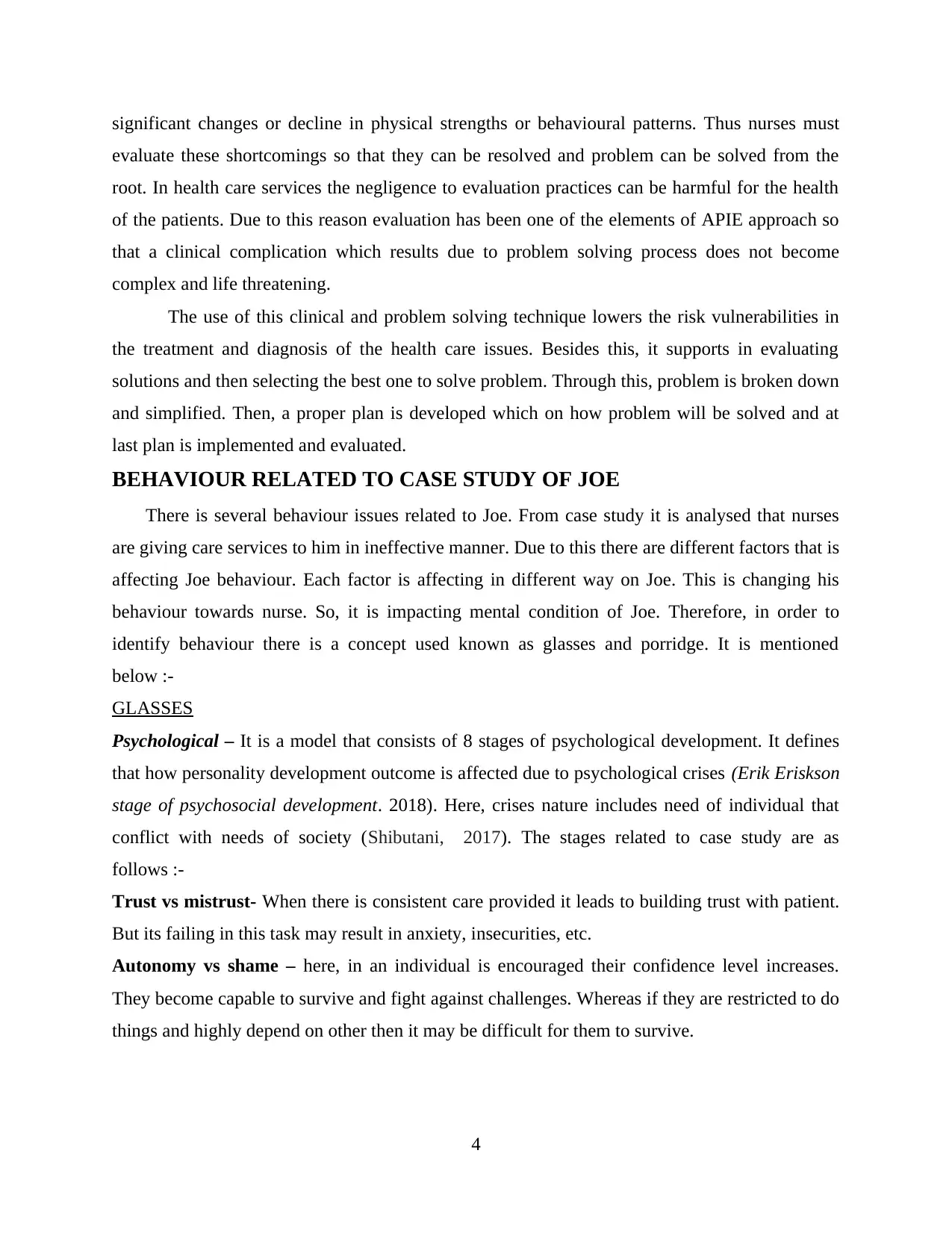
significant changes or decline in physical strengths or behavioural patterns. Thus nurses must
evaluate these shortcomings so that they can be resolved and problem can be solved from the
root. In health care services the negligence to evaluation practices can be harmful for the health
of the patients. Due to this reason evaluation has been one of the elements of APIE approach so
that a clinical complication which results due to problem solving process does not become
complex and life threatening.
The use of this clinical and problem solving technique lowers the risk vulnerabilities in
the treatment and diagnosis of the health care issues. Besides this, it supports in evaluating
solutions and then selecting the best one to solve problem. Through this, problem is broken down
and simplified. Then, a proper plan is developed which on how problem will be solved and at
last plan is implemented and evaluated.
BEHAVIOUR RELATED TO CASE STUDY OF JOE
There is several behaviour issues related to Joe. From case study it is analysed that nurses
are giving care services to him in ineffective manner. Due to this there are different factors that is
affecting Joe behaviour. Each factor is affecting in different way on Joe. This is changing his
behaviour towards nurse. So, it is impacting mental condition of Joe. Therefore, in order to
identify behaviour there is a concept used known as glasses and porridge. It is mentioned
below :-
GLASSES
Psychological – It is a model that consists of 8 stages of psychological development. It defines
that how personality development outcome is affected due to psychological crises (Erik Eriskson
stage of psychosocial development. 2018). Here, crises nature includes need of individual that
conflict with needs of society (Shibutani, 2017). The stages related to case study are as
follows :-
Trust vs mistrust- When there is consistent care provided it leads to building trust with patient.
But its failing in this task may result in anxiety, insecurities, etc.
Autonomy vs shame – here, in an individual is encouraged their confidence level increases.
They become capable to survive and fight against challenges. Whereas if they are restricted to do
things and highly depend on other then it may be difficult for them to survive.
4
evaluate these shortcomings so that they can be resolved and problem can be solved from the
root. In health care services the negligence to evaluation practices can be harmful for the health
of the patients. Due to this reason evaluation has been one of the elements of APIE approach so
that a clinical complication which results due to problem solving process does not become
complex and life threatening.
The use of this clinical and problem solving technique lowers the risk vulnerabilities in
the treatment and diagnosis of the health care issues. Besides this, it supports in evaluating
solutions and then selecting the best one to solve problem. Through this, problem is broken down
and simplified. Then, a proper plan is developed which on how problem will be solved and at
last plan is implemented and evaluated.
BEHAVIOUR RELATED TO CASE STUDY OF JOE
There is several behaviour issues related to Joe. From case study it is analysed that nurses
are giving care services to him in ineffective manner. Due to this there are different factors that is
affecting Joe behaviour. Each factor is affecting in different way on Joe. This is changing his
behaviour towards nurse. So, it is impacting mental condition of Joe. Therefore, in order to
identify behaviour there is a concept used known as glasses and porridge. It is mentioned
below :-
GLASSES
Psychological – It is a model that consists of 8 stages of psychological development. It defines
that how personality development outcome is affected due to psychological crises (Erik Eriskson
stage of psychosocial development. 2018). Here, crises nature includes need of individual that
conflict with needs of society (Shibutani, 2017). The stages related to case study are as
follows :-
Trust vs mistrust- When there is consistent care provided it leads to building trust with patient.
But its failing in this task may result in anxiety, insecurities, etc.
Autonomy vs shame – here, in an individual is encouraged their confidence level increases.
They become capable to survive and fight against challenges. Whereas if they are restricted to do
things and highly depend on other then it may be difficult for them to survive.
4
⊘ This is a preview!⊘
Do you want full access?
Subscribe today to unlock all pages.

Trusted by 1+ million students worldwide
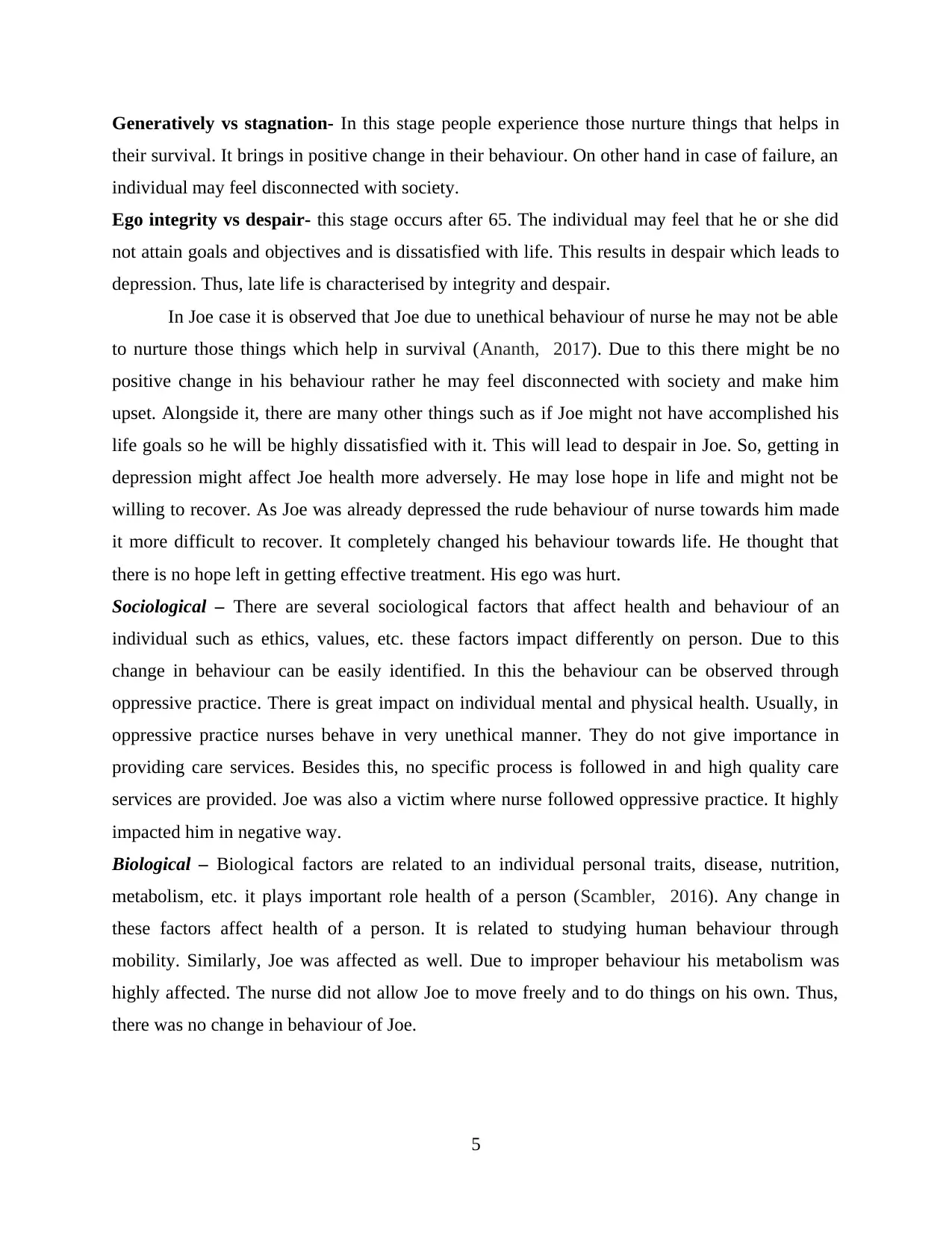
Generatively vs stagnation- In this stage people experience those nurture things that helps in
their survival. It brings in positive change in their behaviour. On other hand in case of failure, an
individual may feel disconnected with society.
Ego integrity vs despair- this stage occurs after 65. The individual may feel that he or she did
not attain goals and objectives and is dissatisfied with life. This results in despair which leads to
depression. Thus, late life is characterised by integrity and despair.
In Joe case it is observed that Joe due to unethical behaviour of nurse he may not be able
to nurture those things which help in survival (Ananth, 2017). Due to this there might be no
positive change in his behaviour rather he may feel disconnected with society and make him
upset. Alongside it, there are many other things such as if Joe might not have accomplished his
life goals so he will be highly dissatisfied with it. This will lead to despair in Joe. So, getting in
depression might affect Joe health more adversely. He may lose hope in life and might not be
willing to recover. As Joe was already depressed the rude behaviour of nurse towards him made
it more difficult to recover. It completely changed his behaviour towards life. He thought that
there is no hope left in getting effective treatment. His ego was hurt.
Sociological – There are several sociological factors that affect health and behaviour of an
individual such as ethics, values, etc. these factors impact differently on person. Due to this
change in behaviour can be easily identified. In this the behaviour can be observed through
oppressive practice. There is great impact on individual mental and physical health. Usually, in
oppressive practice nurses behave in very unethical manner. They do not give importance in
providing care services. Besides this, no specific process is followed in and high quality care
services are provided. Joe was also a victim where nurse followed oppressive practice. It highly
impacted him in negative way.
Biological – Biological factors are related to an individual personal traits, disease, nutrition,
metabolism, etc. it plays important role health of a person (Scambler, 2016). Any change in
these factors affect health of a person. It is related to studying human behaviour through
mobility. Similarly, Joe was affected as well. Due to improper behaviour his metabolism was
highly affected. The nurse did not allow Joe to move freely and to do things on his own. Thus,
there was no change in behaviour of Joe.
5
their survival. It brings in positive change in their behaviour. On other hand in case of failure, an
individual may feel disconnected with society.
Ego integrity vs despair- this stage occurs after 65. The individual may feel that he or she did
not attain goals and objectives and is dissatisfied with life. This results in despair which leads to
depression. Thus, late life is characterised by integrity and despair.
In Joe case it is observed that Joe due to unethical behaviour of nurse he may not be able
to nurture those things which help in survival (Ananth, 2017). Due to this there might be no
positive change in his behaviour rather he may feel disconnected with society and make him
upset. Alongside it, there are many other things such as if Joe might not have accomplished his
life goals so he will be highly dissatisfied with it. This will lead to despair in Joe. So, getting in
depression might affect Joe health more adversely. He may lose hope in life and might not be
willing to recover. As Joe was already depressed the rude behaviour of nurse towards him made
it more difficult to recover. It completely changed his behaviour towards life. He thought that
there is no hope left in getting effective treatment. His ego was hurt.
Sociological – There are several sociological factors that affect health and behaviour of an
individual such as ethics, values, etc. these factors impact differently on person. Due to this
change in behaviour can be easily identified. In this the behaviour can be observed through
oppressive practice. There is great impact on individual mental and physical health. Usually, in
oppressive practice nurses behave in very unethical manner. They do not give importance in
providing care services. Besides this, no specific process is followed in and high quality care
services are provided. Joe was also a victim where nurse followed oppressive practice. It highly
impacted him in negative way.
Biological – Biological factors are related to an individual personal traits, disease, nutrition,
metabolism, etc. it plays important role health of a person (Scambler, 2016). Any change in
these factors affect health of a person. It is related to studying human behaviour through
mobility. Similarly, Joe was affected as well. Due to improper behaviour his metabolism was
highly affected. The nurse did not allow Joe to move freely and to do things on his own. Thus,
there was no change in behaviour of Joe.
5
Paraphrase This Document
Need a fresh take? Get an instant paraphrase of this document with our AI Paraphraser
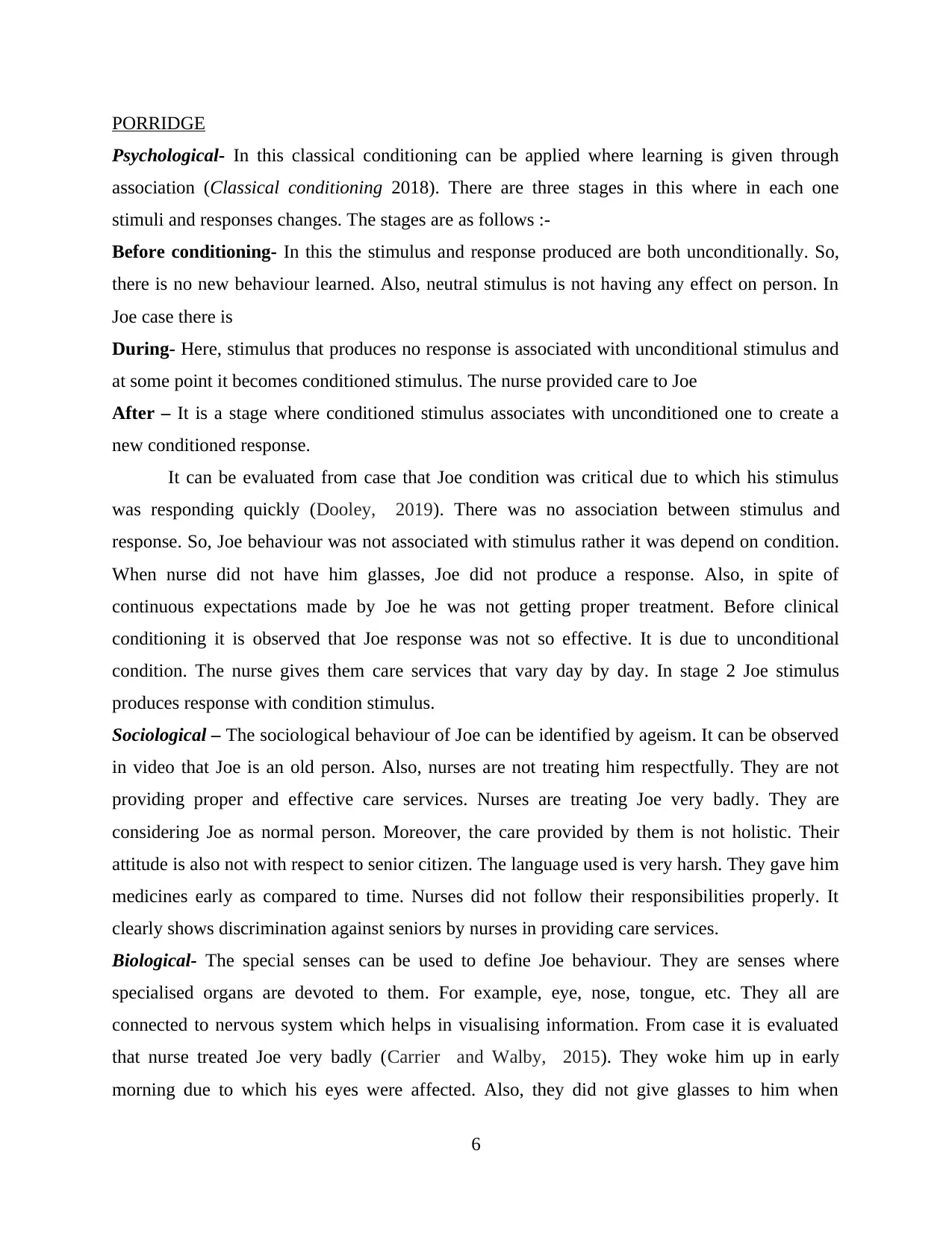
PORRIDGE
Psychological- In this classical conditioning can be applied where learning is given through
association (Classical conditioning 2018). There are three stages in this where in each one
stimuli and responses changes. The stages are as follows :-
Before conditioning- In this the stimulus and response produced are both unconditionally. So,
there is no new behaviour learned. Also, neutral stimulus is not having any effect on person. In
Joe case there is
During- Here, stimulus that produces no response is associated with unconditional stimulus and
at some point it becomes conditioned stimulus. The nurse provided care to Joe
After – It is a stage where conditioned stimulus associates with unconditioned one to create a
new conditioned response.
It can be evaluated from case that Joe condition was critical due to which his stimulus
was responding quickly (Dooley, 2019). There was no association between stimulus and
response. So, Joe behaviour was not associated with stimulus rather it was depend on condition.
When nurse did not have him glasses, Joe did not produce a response. Also, in spite of
continuous expectations made by Joe he was not getting proper treatment. Before clinical
conditioning it is observed that Joe response was not so effective. It is due to unconditional
condition. The nurse gives them care services that vary day by day. In stage 2 Joe stimulus
produces response with condition stimulus.
Sociological – The sociological behaviour of Joe can be identified by ageism. It can be observed
in video that Joe is an old person. Also, nurses are not treating him respectfully. They are not
providing proper and effective care services. Nurses are treating Joe very badly. They are
considering Joe as normal person. Moreover, the care provided by them is not holistic. Their
attitude is also not with respect to senior citizen. The language used is very harsh. They gave him
medicines early as compared to time. Nurses did not follow their responsibilities properly. It
clearly shows discrimination against seniors by nurses in providing care services.
Biological- The special senses can be used to define Joe behaviour. They are senses where
specialised organs are devoted to them. For example, eye, nose, tongue, etc. They all are
connected to nervous system which helps in visualising information. From case it is evaluated
that nurse treated Joe very badly (Carrier and Walby, 2015). They woke him up in early
morning due to which his eyes were affected. Also, they did not give glasses to him when
6
Psychological- In this classical conditioning can be applied where learning is given through
association (Classical conditioning 2018). There are three stages in this where in each one
stimuli and responses changes. The stages are as follows :-
Before conditioning- In this the stimulus and response produced are both unconditionally. So,
there is no new behaviour learned. Also, neutral stimulus is not having any effect on person. In
Joe case there is
During- Here, stimulus that produces no response is associated with unconditional stimulus and
at some point it becomes conditioned stimulus. The nurse provided care to Joe
After – It is a stage where conditioned stimulus associates with unconditioned one to create a
new conditioned response.
It can be evaluated from case that Joe condition was critical due to which his stimulus
was responding quickly (Dooley, 2019). There was no association between stimulus and
response. So, Joe behaviour was not associated with stimulus rather it was depend on condition.
When nurse did not have him glasses, Joe did not produce a response. Also, in spite of
continuous expectations made by Joe he was not getting proper treatment. Before clinical
conditioning it is observed that Joe response was not so effective. It is due to unconditional
condition. The nurse gives them care services that vary day by day. In stage 2 Joe stimulus
produces response with condition stimulus.
Sociological – The sociological behaviour of Joe can be identified by ageism. It can be observed
in video that Joe is an old person. Also, nurses are not treating him respectfully. They are not
providing proper and effective care services. Nurses are treating Joe very badly. They are
considering Joe as normal person. Moreover, the care provided by them is not holistic. Their
attitude is also not with respect to senior citizen. The language used is very harsh. They gave him
medicines early as compared to time. Nurses did not follow their responsibilities properly. It
clearly shows discrimination against seniors by nurses in providing care services.
Biological- The special senses can be used to define Joe behaviour. They are senses where
specialised organs are devoted to them. For example, eye, nose, tongue, etc. They all are
connected to nervous system which helps in visualising information. From case it is evaluated
that nurse treated Joe very badly (Carrier and Walby, 2015). They woke him up in early
morning due to which his eyes were affected. Also, they did not give glasses to him when
6
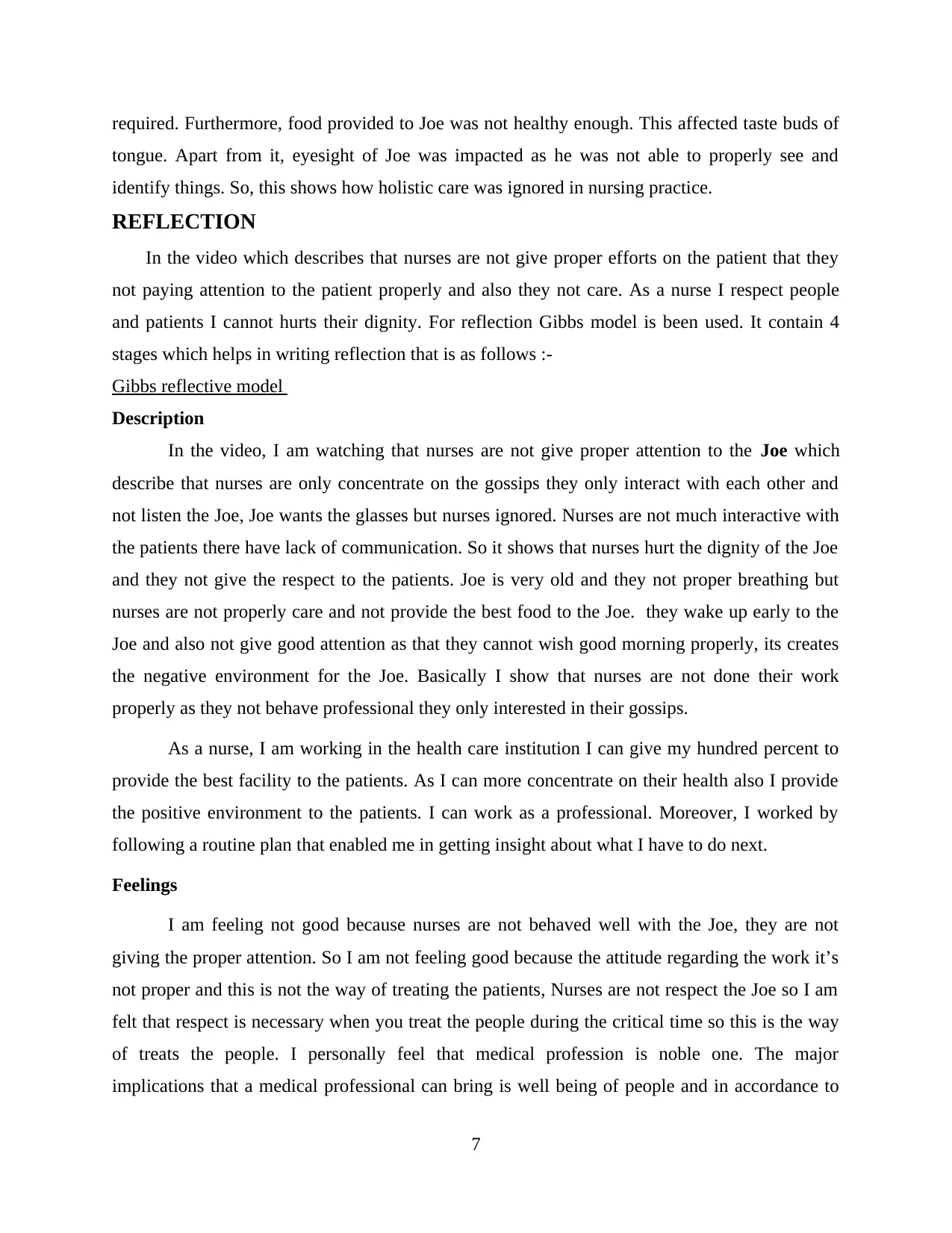
required. Furthermore, food provided to Joe was not healthy enough. This affected taste buds of
tongue. Apart from it, eyesight of Joe was impacted as he was not able to properly see and
identify things. So, this shows how holistic care was ignored in nursing practice.
REFLECTION
In the video which describes that nurses are not give proper efforts on the patient that they
not paying attention to the patient properly and also they not care. As a nurse I respect people
and patients I cannot hurts their dignity. For reflection Gibbs model is been used. It contain 4
stages which helps in writing reflection that is as follows :-
Gibbs reflective model
Description
In the video, I am watching that nurses are not give proper attention to the Joe which
describe that nurses are only concentrate on the gossips they only interact with each other and
not listen the Joe, Joe wants the glasses but nurses ignored. Nurses are not much interactive with
the patients there have lack of communication. So it shows that nurses hurt the dignity of the Joe
and they not give the respect to the patients. Joe is very old and they not proper breathing but
nurses are not properly care and not provide the best food to the Joe. they wake up early to the
Joe and also not give good attention as that they cannot wish good morning properly, its creates
the negative environment for the Joe. Basically I show that nurses are not done their work
properly as they not behave professional they only interested in their gossips.
As a nurse, I am working in the health care institution I can give my hundred percent to
provide the best facility to the patients. As I can more concentrate on their health also I provide
the positive environment to the patients. I can work as a professional. Moreover, I worked by
following a routine plan that enabled me in getting insight about what I have to do next.
Feelings
I am feeling not good because nurses are not behaved well with the Joe, they are not
giving the proper attention. So I am not feeling good because the attitude regarding the work it’s
not proper and this is not the way of treating the patients, Nurses are not respect the Joe so I am
felt that respect is necessary when you treat the people during the critical time so this is the way
of treats the people. I personally feel that medical profession is noble one. The major
implications that a medical professional can bring is well being of people and in accordance to
7
tongue. Apart from it, eyesight of Joe was impacted as he was not able to properly see and
identify things. So, this shows how holistic care was ignored in nursing practice.
REFLECTION
In the video which describes that nurses are not give proper efforts on the patient that they
not paying attention to the patient properly and also they not care. As a nurse I respect people
and patients I cannot hurts their dignity. For reflection Gibbs model is been used. It contain 4
stages which helps in writing reflection that is as follows :-
Gibbs reflective model
Description
In the video, I am watching that nurses are not give proper attention to the Joe which
describe that nurses are only concentrate on the gossips they only interact with each other and
not listen the Joe, Joe wants the glasses but nurses ignored. Nurses are not much interactive with
the patients there have lack of communication. So it shows that nurses hurt the dignity of the Joe
and they not give the respect to the patients. Joe is very old and they not proper breathing but
nurses are not properly care and not provide the best food to the Joe. they wake up early to the
Joe and also not give good attention as that they cannot wish good morning properly, its creates
the negative environment for the Joe. Basically I show that nurses are not done their work
properly as they not behave professional they only interested in their gossips.
As a nurse, I am working in the health care institution I can give my hundred percent to
provide the best facility to the patients. As I can more concentrate on their health also I provide
the positive environment to the patients. I can work as a professional. Moreover, I worked by
following a routine plan that enabled me in getting insight about what I have to do next.
Feelings
I am feeling not good because nurses are not behaved well with the Joe, they are not
giving the proper attention. So I am not feeling good because the attitude regarding the work it’s
not proper and this is not the way of treating the patients, Nurses are not respect the Joe so I am
felt that respect is necessary when you treat the people during the critical time so this is the way
of treats the people. I personally feel that medical profession is noble one. The major
implications that a medical professional can bring is well being of people and in accordance to
7
⊘ This is a preview!⊘
Do you want full access?
Subscribe today to unlock all pages.

Trusted by 1+ million students worldwide
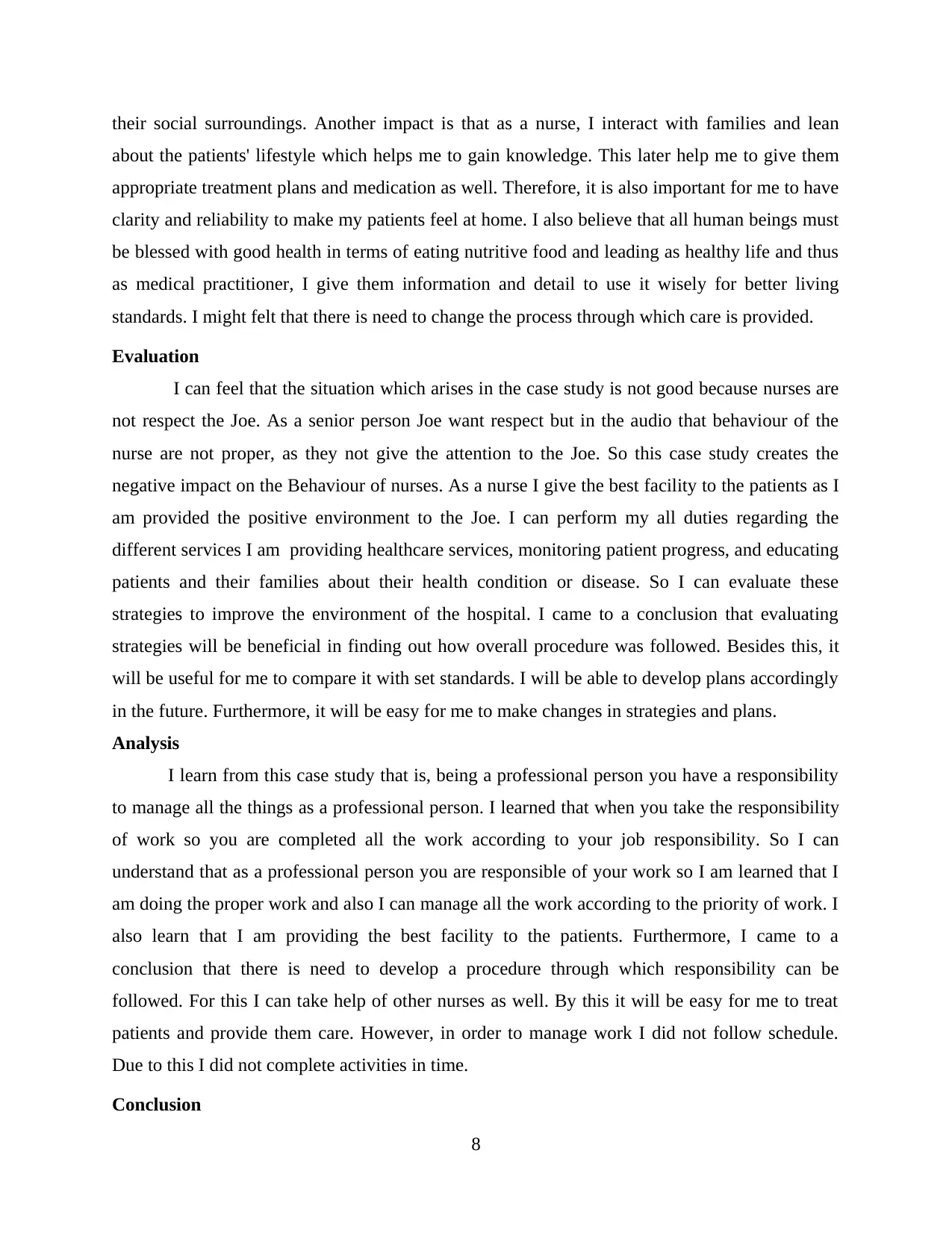
their social surroundings. Another impact is that as a nurse, I interact with families and lean
about the patients' lifestyle which helps me to gain knowledge. This later help me to give them
appropriate treatment plans and medication as well. Therefore, it is also important for me to have
clarity and reliability to make my patients feel at home. I also believe that all human beings must
be blessed with good health in terms of eating nutritive food and leading as healthy life and thus
as medical practitioner, I give them information and detail to use it wisely for better living
standards. I might felt that there is need to change the process through which care is provided.
Evaluation
I can feel that the situation which arises in the case study is not good because nurses are
not respect the Joe. As a senior person Joe want respect but in the audio that behaviour of the
nurse are not proper, as they not give the attention to the Joe. So this case study creates the
negative impact on the Behaviour of nurses. As a nurse I give the best facility to the patients as I
am provided the positive environment to the Joe. I can perform my all duties regarding the
different services I am providing healthcare services, monitoring patient progress, and educating
patients and their families about their health condition or disease. So I can evaluate these
strategies to improve the environment of the hospital. I came to a conclusion that evaluating
strategies will be beneficial in finding out how overall procedure was followed. Besides this, it
will be useful for me to compare it with set standards. I will be able to develop plans accordingly
in the future. Furthermore, it will be easy for me to make changes in strategies and plans.
Analysis
I learn from this case study that is, being a professional person you have a responsibility
to manage all the things as a professional person. I learned that when you take the responsibility
of work so you are completed all the work according to your job responsibility. So I can
understand that as a professional person you are responsible of your work so I am learned that I
am doing the proper work and also I can manage all the work according to the priority of work. I
also learn that I am providing the best facility to the patients. Furthermore, I came to a
conclusion that there is need to develop a procedure through which responsibility can be
followed. For this I can take help of other nurses as well. By this it will be easy for me to treat
patients and provide them care. However, in order to manage work I did not follow schedule.
Due to this I did not complete activities in time.
Conclusion
8
about the patients' lifestyle which helps me to gain knowledge. This later help me to give them
appropriate treatment plans and medication as well. Therefore, it is also important for me to have
clarity and reliability to make my patients feel at home. I also believe that all human beings must
be blessed with good health in terms of eating nutritive food and leading as healthy life and thus
as medical practitioner, I give them information and detail to use it wisely for better living
standards. I might felt that there is need to change the process through which care is provided.
Evaluation
I can feel that the situation which arises in the case study is not good because nurses are
not respect the Joe. As a senior person Joe want respect but in the audio that behaviour of the
nurse are not proper, as they not give the attention to the Joe. So this case study creates the
negative impact on the Behaviour of nurses. As a nurse I give the best facility to the patients as I
am provided the positive environment to the Joe. I can perform my all duties regarding the
different services I am providing healthcare services, monitoring patient progress, and educating
patients and their families about their health condition or disease. So I can evaluate these
strategies to improve the environment of the hospital. I came to a conclusion that evaluating
strategies will be beneficial in finding out how overall procedure was followed. Besides this, it
will be useful for me to compare it with set standards. I will be able to develop plans accordingly
in the future. Furthermore, it will be easy for me to make changes in strategies and plans.
Analysis
I learn from this case study that is, being a professional person you have a responsibility
to manage all the things as a professional person. I learned that when you take the responsibility
of work so you are completed all the work according to your job responsibility. So I can
understand that as a professional person you are responsible of your work so I am learned that I
am doing the proper work and also I can manage all the work according to the priority of work. I
also learn that I am providing the best facility to the patients. Furthermore, I came to a
conclusion that there is need to develop a procedure through which responsibility can be
followed. For this I can take help of other nurses as well. By this it will be easy for me to treat
patients and provide them care. However, in order to manage work I did not follow schedule.
Due to this I did not complete activities in time.
Conclusion
8
Paraphrase This Document
Need a fresh take? Get an instant paraphrase of this document with our AI Paraphraser
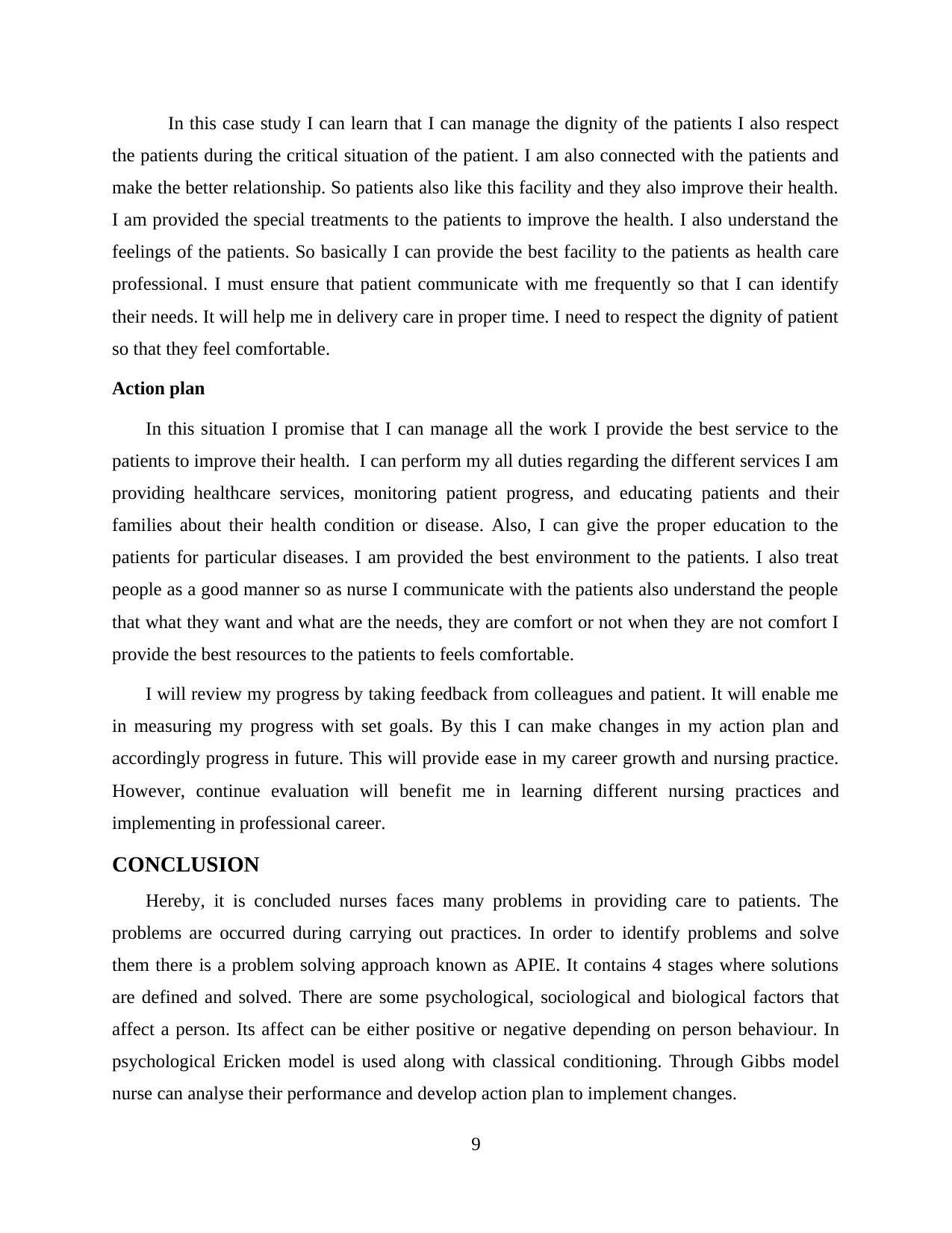
In this case study I can learn that I can manage the dignity of the patients I also respect
the patients during the critical situation of the patient. I am also connected with the patients and
make the better relationship. So patients also like this facility and they also improve their health.
I am provided the special treatments to the patients to improve the health. I also understand the
feelings of the patients. So basically I can provide the best facility to the patients as health care
professional. I must ensure that patient communicate with me frequently so that I can identify
their needs. It will help me in delivery care in proper time. I need to respect the dignity of patient
so that they feel comfortable.
Action plan
In this situation I promise that I can manage all the work I provide the best service to the
patients to improve their health. I can perform my all duties regarding the different services I am
providing healthcare services, monitoring patient progress, and educating patients and their
families about their health condition or disease. Also, I can give the proper education to the
patients for particular diseases. I am provided the best environment to the patients. I also treat
people as a good manner so as nurse I communicate with the patients also understand the people
that what they want and what are the needs, they are comfort or not when they are not comfort I
provide the best resources to the patients to feels comfortable.
I will review my progress by taking feedback from colleagues and patient. It will enable me
in measuring my progress with set goals. By this I can make changes in my action plan and
accordingly progress in future. This will provide ease in my career growth and nursing practice.
However, continue evaluation will benefit me in learning different nursing practices and
implementing in professional career.
CONCLUSION
Hereby, it is concluded nurses faces many problems in providing care to patients. The
problems are occurred during carrying out practices. In order to identify problems and solve
them there is a problem solving approach known as APIE. It contains 4 stages where solutions
are defined and solved. There are some psychological, sociological and biological factors that
affect a person. Its affect can be either positive or negative depending on person behaviour. In
psychological Ericken model is used along with classical conditioning. Through Gibbs model
nurse can analyse their performance and develop action plan to implement changes.
9
the patients during the critical situation of the patient. I am also connected with the patients and
make the better relationship. So patients also like this facility and they also improve their health.
I am provided the special treatments to the patients to improve the health. I also understand the
feelings of the patients. So basically I can provide the best facility to the patients as health care
professional. I must ensure that patient communicate with me frequently so that I can identify
their needs. It will help me in delivery care in proper time. I need to respect the dignity of patient
so that they feel comfortable.
Action plan
In this situation I promise that I can manage all the work I provide the best service to the
patients to improve their health. I can perform my all duties regarding the different services I am
providing healthcare services, monitoring patient progress, and educating patients and their
families about their health condition or disease. Also, I can give the proper education to the
patients for particular diseases. I am provided the best environment to the patients. I also treat
people as a good manner so as nurse I communicate with the patients also understand the people
that what they want and what are the needs, they are comfort or not when they are not comfort I
provide the best resources to the patients to feels comfortable.
I will review my progress by taking feedback from colleagues and patient. It will enable me
in measuring my progress with set goals. By this I can make changes in my action plan and
accordingly progress in future. This will provide ease in my career growth and nursing practice.
However, continue evaluation will benefit me in learning different nursing practices and
implementing in professional career.
CONCLUSION
Hereby, it is concluded nurses faces many problems in providing care to patients. The
problems are occurred during carrying out practices. In order to identify problems and solve
them there is a problem solving approach known as APIE. It contains 4 stages where solutions
are defined and solved. There are some psychological, sociological and biological factors that
affect a person. Its affect can be either positive or negative depending on person behaviour. In
psychological Ericken model is used along with classical conditioning. Through Gibbs model
nurse can analyse their performance and develop action plan to implement changes.
9
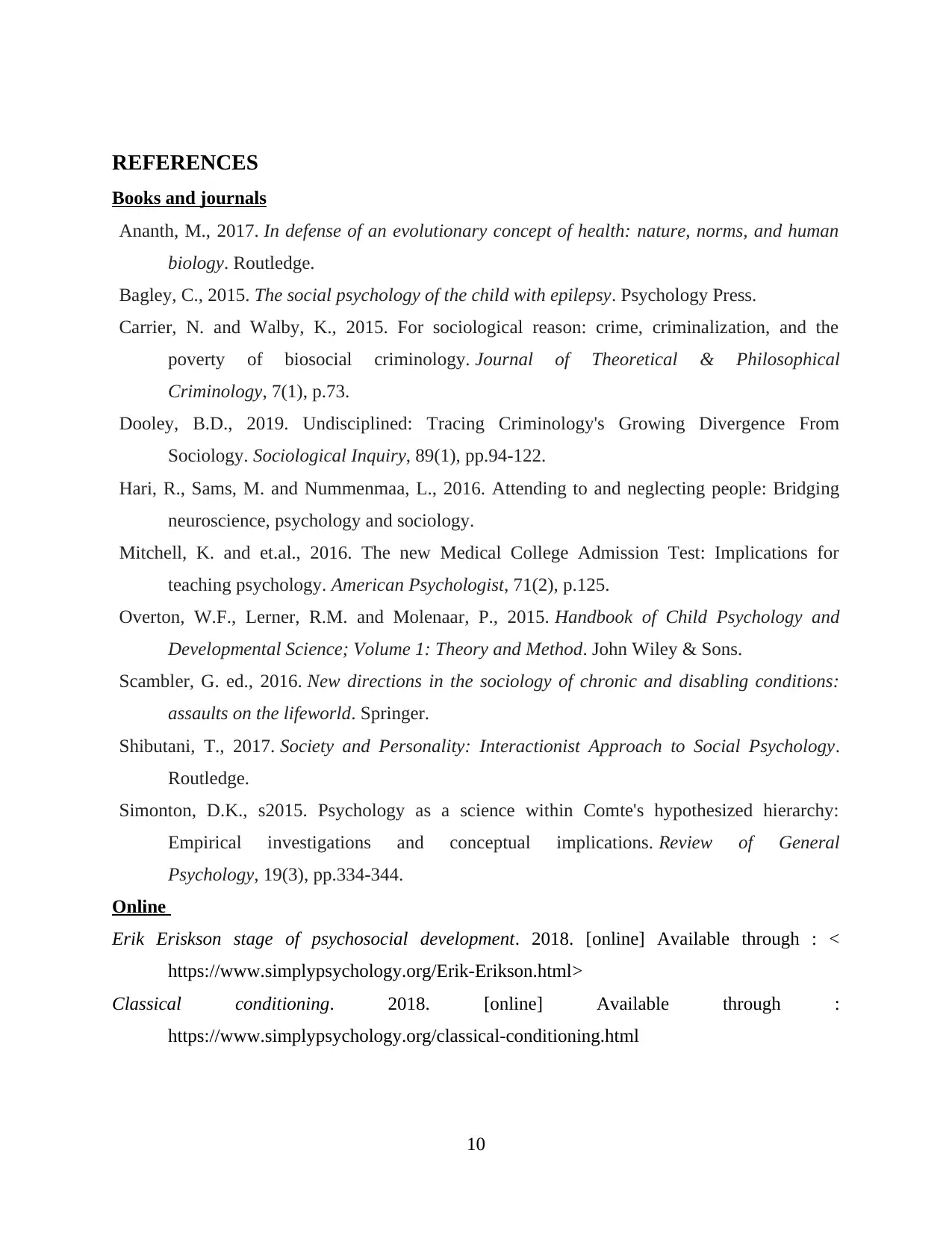
REFERENCES
Books and journals
Ananth, M., 2017. In defense of an evolutionary concept of health: nature, norms, and human
biology. Routledge.
Bagley, C., 2015. The social psychology of the child with epilepsy. Psychology Press.
Carrier, N. and Walby, K., 2015. For sociological reason: crime, criminalization, and the
poverty of biosocial criminology. Journal of Theoretical & Philosophical
Criminology, 7(1), p.73.
Dooley, B.D., 2019. Undisciplined: Tracing Criminology's Growing Divergence From
Sociology. Sociological Inquiry, 89(1), pp.94-122.
Hari, R., Sams, M. and Nummenmaa, L., 2016. Attending to and neglecting people: Bridging
neuroscience, psychology and sociology.
Mitchell, K. and et.al., 2016. The new Medical College Admission Test: Implications for
teaching psychology. American Psychologist, 71(2), p.125.
Overton, W.F., Lerner, R.M. and Molenaar, P., 2015. Handbook of Child Psychology and
Developmental Science; Volume 1: Theory and Method. John Wiley & Sons.
Scambler, G. ed., 2016. New directions in the sociology of chronic and disabling conditions:
assaults on the lifeworld. Springer.
Shibutani, T., 2017. Society and Personality: Interactionist Approach to Social Psychology.
Routledge.
Simonton, D.K., s2015. Psychology as a science within Comte's hypothesized hierarchy:
Empirical investigations and conceptual implications. Review of General
Psychology, 19(3), pp.334-344.
Online
Erik Eriskson stage of psychosocial development. 2018. [online] Available through : <
https://www.simplypsychology.org/Erik-Erikson.html>
Classical conditioning. 2018. [online] Available through :
https://www.simplypsychology.org/classical-conditioning.html
10
Books and journals
Ananth, M., 2017. In defense of an evolutionary concept of health: nature, norms, and human
biology. Routledge.
Bagley, C., 2015. The social psychology of the child with epilepsy. Psychology Press.
Carrier, N. and Walby, K., 2015. For sociological reason: crime, criminalization, and the
poverty of biosocial criminology. Journal of Theoretical & Philosophical
Criminology, 7(1), p.73.
Dooley, B.D., 2019. Undisciplined: Tracing Criminology's Growing Divergence From
Sociology. Sociological Inquiry, 89(1), pp.94-122.
Hari, R., Sams, M. and Nummenmaa, L., 2016. Attending to and neglecting people: Bridging
neuroscience, psychology and sociology.
Mitchell, K. and et.al., 2016. The new Medical College Admission Test: Implications for
teaching psychology. American Psychologist, 71(2), p.125.
Overton, W.F., Lerner, R.M. and Molenaar, P., 2015. Handbook of Child Psychology and
Developmental Science; Volume 1: Theory and Method. John Wiley & Sons.
Scambler, G. ed., 2016. New directions in the sociology of chronic and disabling conditions:
assaults on the lifeworld. Springer.
Shibutani, T., 2017. Society and Personality: Interactionist Approach to Social Psychology.
Routledge.
Simonton, D.K., s2015. Psychology as a science within Comte's hypothesized hierarchy:
Empirical investigations and conceptual implications. Review of General
Psychology, 19(3), pp.334-344.
Online
Erik Eriskson stage of psychosocial development. 2018. [online] Available through : <
https://www.simplypsychology.org/Erik-Erikson.html>
Classical conditioning. 2018. [online] Available through :
https://www.simplypsychology.org/classical-conditioning.html
10
⊘ This is a preview!⊘
Do you want full access?
Subscribe today to unlock all pages.

Trusted by 1+ million students worldwide
1 out of 12
Related Documents
Your All-in-One AI-Powered Toolkit for Academic Success.
+13062052269
info@desklib.com
Available 24*7 on WhatsApp / Email
![[object Object]](/_next/static/media/star-bottom.7253800d.svg)
Unlock your academic potential
Copyright © 2020–2025 A2Z Services. All Rights Reserved. Developed and managed by ZUCOL.





